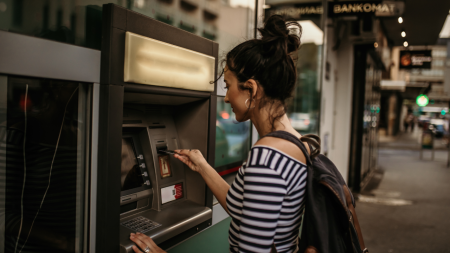Images by Getty Images; Illustration by Austin Courregé/Bankrate
A high-yield savings account earning 4.40 percent APY would generate almost $450 in interest on a $10,000 deposit over one year. This is over seven times more than the national average savings rate of 0.6 percent APY, which would only earn around $60 annually.
High-yield savings accounts offer easy access to your money while providing competitive returns, making them ideal for emergency funds and short-term financial goals.
Key takeaways
- $10,000 in a competitive high-yield savings account (4.40 percent APY) earns $449.80 in one year.
- Big bank savings accounts (0.01 percent APY) would earn only $1 on $10,000 per year.
- High-yield accounts are best for emergency funds and short-term savings goals with specific timelines.
How much will $10,000 make in a high-yield savings account?
The amount your $10,000 will earn depends entirely on the annual percentage yield (APY) your account offers. Here’s how different types of savings accounts compare when holding $10,000 for one full year:
| Type of savings account | Typical APY | Interest earned on $10,000 | Total after 1 year |
|---|---|---|---|
| High-yield savings account | 4.40% | $449.80 | $10,449.80 |
| National average savings account | 0.60% | $60.18 | $10,060.18 |
| Big bank savings account | 0.01% | $1 | $10,001 |
The yields on savings accounts are variable, meaning banks can raise or lower them at any time. Banks offering top rates tend to increase yields when the Federal Reserve raises rates, and they often decrease yields when the Fed lowers rates.
What makes high-yield savings accounts earn more?
The top high-yield savings accounts typically offer rates between 3.75% and 4.40% APY, significantly higher than traditional savings accounts. These competitive rates are often found at online banks, which can offer higher yields because they don’t have the overhead costs of maintaining physical branches.
Bankrate Insight: When to choose a high-yield savings account
“I recommend high-yield savings accounts for emergency funds and any money you’ll need within the next two years. The combination of higher returns and easy access makes them great for short-term goals like saving for a vacation or building your safety net. Just make sure the account is FDIC-insured and has minimal fees.”
— Hanna Horvath, Managing Editor, Banking
Who should get a high-yield savings account?
Anyone building an emergency fund or saving for short-term goals would benefit from a high-yield savings account. These accounts provide the perfect balance of accessibility and growth for money you might need within the next few years.
High-yield savings accounts work best for:
- Emergency funds (3-6 months of expenses)
- Short-term savings goals with specific timelines
- Money you want to keep liquid but still growing
- Funds you’re setting aside for major purchases
How to find the best high-yield savings account
When shopping for a high-yield savings account, focus on these key factors:
Interest rate: Look for accounts offering competitive APYs. Remember that rates can change, so consider the bank’s history of competitive pricing.
Fees: Avoid accounts with monthly maintenance fees or minimum balance requirements that could eat into your earnings. Many top online banks offer fee-free accounts.
FDIC insurance: Ensure your chosen account is FDIC-insured up to $250,000 per depositor, per bank, per ownership category.
Access and convenience: Consider whether you need features like ATM access, mobile check deposit or online banking tools.
Are high-yield savings accounts safe?
Your money in a savings account is safe as long as it’s at a bank that’s insured by the Federal Deposit Insurance fund (FDIC) and within the set limits and guidelines. The FDIC insures up to $250,000 per depositor, per FDIC-insured bank, per ownership category.
Similarly, money in a credit union is protected when the credit union is a member of the National Credit Union Administration (NCUA). The NCUA manages the National Credit Union Share Insurance Fund (NCUSIF), which guarantees your money is safe. This insurance is similar to that of the FDIC, with a $250,000 cap for each account and owner.
High-yield savings accounts vs. other options
High-yield savings vs. CDs
While certificates of deposit (CDs) often offer slightly higher rates, they require you to lock up your money for a set term. High-yield savings accounts provide more flexibility with competitive rates. Consider a high-yield savings account if you want easy access to your money, you’re building an emergency fund or interest rates are rising (you can benefit from rate increases).
Alternatively, consider a CD if you have a specific timeline for your savings goal, you’re certain you won’t need the money before maturity and you want to lock in today’s rates.
Related: High-yield savings account vs. CD: Which is better for your savings goals?
High-yield savings vs. money market accounts
Money market accounts often offer similar rates to high-yield savings accounts but may provide additional features like check-writing privileges and debit card access.
Pros and cons of savings accounts
Pros
- Rates significantly above the national average
- Easy access to your money for emergencies
- Your funds are insured up to federal limits
- Variable rates can rise with Federal Reserve rate hikes
Cons
- APYs can decrease when the Fed lowers rates
- Many high-yield accounts are at online banks without physical branches
- Federal regulations may limit certain types of withdrawals to six per month
- You might earn more in riskier investments over the long term
Bottom line
A high-yield savings account can significantly boost your earnings compared to traditional savings accounts. With $10,000, the difference between earning $1 and $450 annually is substantial — that extra $449 could cover several months of groceries or contribute to your next financial goal.
The key is finding an account that offers competitive rates, minimal fees and the features you need. Start by comparing options and consider opening an account at an online bank known for consistently competitive rates.
Next steps:
Why we ask for feedback
Your feedback helps us improve our content and services. It takes less than a minute to
complete.
Your responses are anonymous and will only be used for improving our website.
Help us improve our content
Read the full article here












